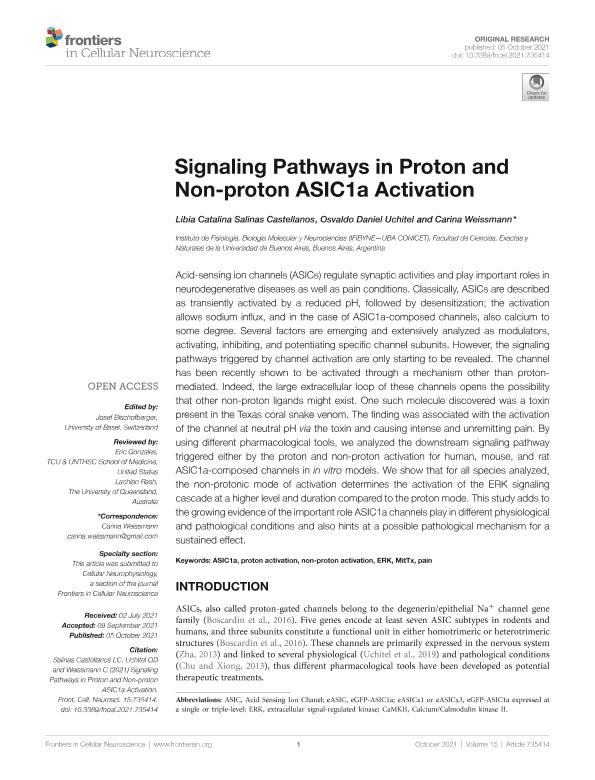Artículo
Signaling Pathways in Proton and Non-proton ASIC1a Activation
Fecha de publicación:
10/2021
Editorial:
Frontiers Media
Revista:
Frontiers in Cellular Neuroscience
e-ISSN:
1662-5102
Idioma:
Inglés
Tipo de recurso:
Artículo publicado
Clasificación temática:
Resumen
Acid-sensing ion channels (ASICs) regulate synaptic activities and play important roles in neurodegenerative diseases as well as pain conditions. Classically, ASICs are described as transiently activated by a reduced pH, followed by desensitization; the activation allows sodium influx, and in the case of ASIC1a-composed channels, also calcium to some degree. Several factors are emerging and extensively analyzed as modulators, activating, inhibiting, and potentiating specific channel subunits. However, the signaling pathways triggered by channel activation are only starting to be revealed.The channel has been recently shown to be activated through a mechanism other than proton-mediated. Indeed, the large extracellular loop of these channels opens the possibility that other non-proton ligands might exist. One such molecule discovered was a toxin present in the Texas coral snake venom. The finding was associated with the activation of the channel at neutral pH via the toxin and causing intense and unremitting pain.By using different pharmacological tools, we analyzed the downstream signaling pathway triggered either by the proton and non-proton activation for human, mouse, and rat ASIC1a-composed channels in in vitro models. We show that for all species analyzed, the non-protonic mode of activation determines the activation of the ERK signaling cascade at a higher level and duration compared to the proton mode.This study adds to the growing evidence of the important role ASIC1a channels play in different physiological and pathological conditions and also hints at a possible pathological mechanism for a sustained effect.
Palabras clave:
ASIC1A
,
ERK
,
MITTX
,
NON-PROTON ACTIVATION
,
PAIN
,
PROTON ACTIVATION
Archivos asociados
Licencia
Identificadores
Colecciones
Articulos(IFIBYNE)
Articulos de INST.DE FISIOL., BIOL.MOLECULAR Y NEUROCIENCIAS
Articulos de INST.DE FISIOL., BIOL.MOLECULAR Y NEUROCIENCIAS
Citación
Salinas Castellanos, Libia Catalina; Uchitel, Osvaldo Daniel; Weissmann, Carina; Signaling Pathways in Proton and Non-proton ASIC1a Activation; Frontiers Media; Frontiers in Cellular Neuroscience; 15; 735414; 10-2021; 1-9
Compartir
Altmétricas




